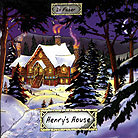July 2002
I might as well get this out of the way right off the bat: this ain’t no Tommy. But it’s no throwaway either. There is much to like on Henry’s House: catchy tunes, humable melodies, bouncy music and a supernatural storyline. But within that framework lies the upside as well as the downfall of this double-disc set. For without the visual cues a live opera normally provides, it’s hard not to let one's mind wander. And, as is true of many operas, the nonsensical storyline doesn’t help in holding one's attention, either. The story, such as it is, tells of love, betrayal, forgiveness, and, of course, the obligatory happy ending. Henry’s House is the story of eight kids: Henry, Serafina, Milo, Little Jack, Lucie, Madeline, Felix and Lily. The kids are aided in the opera by a mystical teacher/witch named Tess and a hero called Crazy Davie. And of course there is the evil villain, Demon Volcano Boy, along with his two henchmen, Bugsy Beals and Crafty Fox. In the story, the kids are sent by their parents to a house "up north" occupied by Tess. While there, they are kidnapped, rescued and discover Henry’s magical powers (sound familiar?). Finally, there is the fateful ultimate showdown with the evil Demon Volcano Boy. What can, and should, hold one's attention is the music. On Henry’s House some of the songs are strong and interesting, such as "Volcano Boy," "Cinnamon Tea," "Morning Teacher Tess," and "Hey Henry" from disc one, and "Hey Henry, part 2," "Sneaky Jack," "Miracle Time" and "The Free Kids Shimmy Shake" from disc two. The trouble is there just aren’t enough of them, nor enough diversity among them, to keep one's ears locked into the story. Perhaps it’s a limitation of the genre, or just its overall lengthiness (two full CDs worth), which conspires against it. But whatever the reason, as Emperor Joseph II told Mozart in Amadeus, there are just "too many notes." Even so, Henry’s House makes for an interesting listen, at least once. The musicianship is not in question here. Faber, who plays all guitars (both acoustic and electric), bass, piano, B3, synth, Wurlitzer, percussion and performs most lead and backing vocals, has more than his share of ability. Faber is backed here by musicians Ted Marotta on drums and percussion; Todd Pasternack on acoustic guitar, bass and backing vocals; Tom Pirozzi on bass and vocals; Jason Crosby on piano; Peter Levin on B3 and synth; and Angela Ford singing background and lead vocals. The sonics encoded on Henry’s House are a cut above the usual rock production. While it’s easy to tell that this is a multitrack studio effort, some care has been taken to provide a somewhat wide, deep soundstage, as would befit a true opera. The biggest problems are its indistinct bass and rolled-off top-end. That Lo Faber and Henry’s House fail to live up to the standards set by The Who with Tommy shouldn’t come as a huge surprise. Following a masterpiece is never easy. Faber deserves credit for making the attempt. Henry’s House demonstrates that creating a rock opera requires a fair bit of forethought to keep the ideas fresh and the story interesting. While I can’t give Henry’s House an unqualified recommendation, you might just find yourself deleting the term "rock opera" from the oxymoron category altogether. GO BACK TO: |
 Lo Faber - Henry's House
Lo Faber - Henry's House![[Reviewed on DVD]](../format/regcd.gif) When
you hear the term oxymoron, what comes to mind? Jumbo shrimp? Military intelligence (that
one was too easy)? Genuine imitation? Sure. But how about "rock opera"?
Hadn’t thought of that one, had you? Maybe that’s because outside of the
Who’s Tommy, which defined the genre, there were very few others to choose
from? Lo Faber’s new CD, Henry’s House, gave me a reason to re-examine
rock opera’s place in music.
When
you hear the term oxymoron, what comes to mind? Jumbo shrimp? Military intelligence (that
one was too easy)? Genuine imitation? Sure. But how about "rock opera"?
Hadn’t thought of that one, had you? Maybe that’s because outside of the
Who’s Tommy, which defined the genre, there were very few others to choose
from? Lo Faber’s new CD, Henry’s House, gave me a reason to re-examine
rock opera’s place in music.